
U.S. President Donald Trump will restore his "maximum pressure" campaign on Iran and drive its oil exports down to zero, a U.S. official said on Tuesday.
Iran has repeatedly threatened to close the Strait of Hormuz for traffic as a retaliation for Western pressure. That would shut down the region's trade and lead to a spike in oil prices.
The Streit of Hormuz & Oil
The strait lies between Oman and Iran and links the Gulf north of it with the Gulf of Oman to the south and the Arabian Sea beyond.
It is 21 miles (33 km) wide at its narrowest point, with the shipping lane just two miles (three km) wide in either direction.
About a fifth of the world's total oil consumption passes through the Strait or some 18-19 million barrels per day (bpd) of oil, condensate and fuel.
OPEC members Saudi Arabia, Iran, the UAE, Kuwait and Iraq export most of their crude via the Strait, mainly to Asia.
The United Arab Emirates and Saudi Arabia have sought to find other routes to bypass the Strait. The U.S. government says that 2.6 million bpd of unused capacity from existing UAE and Saudi pipelines could be available to bypass Hormuz.
Qatar, the world's biggest liquefied natural gas (LNG) exporter, sends almost all of its LNG through the Strait, accounting for around a quarter of global LNG use. Iran has threatened over the years to block the strait but never followed through. The U.S. Fifth Fleet, based in Bahrain, is tasked with protecting commercial shipping in the area.
A Timeline of Tension



